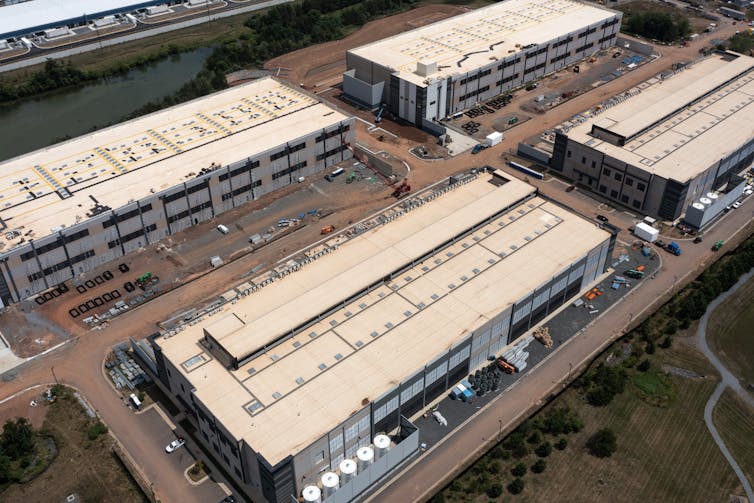
By Hannah Wiseman and Seth Blumsack
Americans’ electricity bills tend to tick up each year in line with inflation.
But upgrades to electric wires, reinforcing and protecting power lines from severe weather, and changing fuel costs – among other factors – are sending rates soaring.
High electricity consumption from data centers and other sources of rising demand will likely cause further increases in the near future.
The impact on consumers is particularly dramatic in Pennsylvania, where rate hikes are widespread.
For example, the monthly bill for a PECO residential customer who uses 700 kilowatt hours of electricity monthly increased 10% – or US$13.58 – in 2025. These bills will go up another $2.70 each month in 2026.
Retail price adjustments approved by the Pennsylvania Public Utility Commission for most electric distribution utilities effective December 2024 led to higher bills for many customers across the state. In some parts of Pennsylvania, the estimated increases topped an estimated 30%.
As professors who work in the areas of energy law and electricity markets, we know electricity costs are rising in many parts of the U.S.
But Pennsylvania faces distinct challenges related to its electric grid – the maze of wires and generators – that drive both the growing demand for electricity and the limited supply.
PJM and the electric grid
Pennsylvania power plants produce a lot of electricity. In fact, the Keystone State is the the largest exporter of electricity in the U.S. and has been for many years.
But the electricity Pennsylvania produces doesn’t always stay in state.
That’s because Pennsylvania’s electric grid is managed by a company called PJM. PJM coordinates the flow of electricity through all or parts of 13 states and the District of Columbia, and it ensures the wholesale electricity transmission system operates reliably and safely.
Pennsylvania electric utilities, such as PECO or Duquesne Light, then distribute this wholesale electricity to retail customers, including homeowners and renters.
PJM requires the utilities to ensure ahead of time that they can meet their customers’ future electricity demands, including during heat waves and winter storms. This requirement is met using a market called a “capacity auction,” in which electricity suppliers bid to provide physical infrastructure that will generate electricity in the future.
The prices at the 2025-2026 PJM capacity auction were more than 800% higher than the previous year, in part due to the growing demand for electricity within PJM. This amounts to tens of billions of dollars in extra costs.
Power plants in Pennsylvania can’t simply stop exporting electricity and supply more in-state power because they dispatch their power into the regional grid operated by PJM, and the flow of electricity is dictated by the physical structure of this grid.

Nathan Howard via Getty Images
Soaring demand from data centers
U.S. electricity demand rose 3% in 2024 and is expected to rise even more rapidly in the coming years.
Much of this new demand comes from data centers, which support everything from AI applications and data storage – think of the thousands of emails and files backed up on our computers – to sports betting, online retailers such as Amazon, and national security applications such as the North American Aerospace Defense Command.
Pennsylvania is on the same electric grid as Virginia, which hosts about a quarter of all data center capacity in the Americas. New data centers are also being built in Pennsylvania.
Rising demand is also driven by the increase in electric vehicles and the replacement of gas- and oil-based furnaces with electric heat pumps. These replacements are ultimately more energy efficient but require electricity.
Bottlenecks in supply
The increase in electricity demand within PJM is happening at the same time that supply is shrinking.
Many old generating plants in the PJM grid are retiring as they near the end of their useful lives and become less profitable for plant operators, particularly as natural gas and solar become more affordable. Some of these older power plants also emit a lot of pollution and are costly to retrofit to meet current pollution limits.
Beyond the challenge of plant retirements, PJM has been slow to allow hundreds of new proposed power plants – most of them solar- and battery-based – to connect to transmission lines.
This long “interconnection queue” prevents new, needed generation from coming online. This is happening even though companies are eager and ready to build more generation and battery storage.
Aging infrastructure and growing weather extremes
One of the primary recent drivers of high consumer electric bills is that the utilities have been slow to upgrade their aging wires.
Many have recently made major investments in new infrastructure and in some cases are burying or strengthening wires to protect them from increasingly extreme weather.
Electricity customers are footing the bill for this work.

David Espejo/Moment Collection via Getty Images
Response from policymakers
In response to rising electricity prices, Pennsylvania Gov. Josh Shapiro filed a legal complaint with the Federal Energy Regulatory Commission against PJM in December 2024. This complaint blamed PJM’s capacity auction design for creating unnecessary costs for consumers.
According to the settlement reached after the complaint, PJM’s price caps will be 35% lower at the next major capacity auction. This reduction in wholesale prices could limit retail price increases.
But this is at best a temporary fix. It doesn’t address the increasing demand, aging power infrastructure battered by extreme weather, or transmission bottleneck.
In order for Pennsylvania residents to see lower electric bills anytime soon, more changes are needed. For example, many experts previously observed that PJM needs to fix the queue and get online the many power plants that are ready to build and just waiting for a transmission interconnection.
While PJM has reformed its queue process, the queue is still long. New power plants are not going up fast enough, in part due to additional challenges such as local opposition and supply chain and financing issues.
![]()
Hannah Wiseman is Professor of Law and Seth Blumsack is Professor of Energy and Environmental Economics and International Affairs, both at Penn State University.




























DaleL says
Contrary to what Hannah Wiseman and Seth Blumsack would have us believe, Pennsylvania electricity rates are not particularly high. The electric rate rose by just 2.4% from last year to this year. That is basically the rate of inflation.
Perhaps data centers are being located in Virginia because the business cost of electricity there is cheaper than the rate of Pennsylvania (9 cents/kWh versus 12 cents/kWh) For reference, the business rate in Florida is 12 cents/kWh.
Residential rates are higher: 15 cents, 18 cents, & 15 cents/kWh respectively for Virginia, Pennsylvania, & Florida.
https://www.chooseenergy.com/electricity-rates-by-state/
Pogo says
@It’s hard out here
… for a billionaire. Just ask one.
Deborah Coffey says
Sure, keep voting for the billionaires and data centers. They’ll make you pay!
Below is a quote from the article by Public Citizen: https://www.citizen.org/article/pjm-executives-not-consumers-pay-nerc-reliability-penalty/
“For example, according to PJM’s FERC Form 1 filing, PJM paid its CEO Manu Asthana an annual salary of $900,000. PJM’s disclosure to FERC significantly underreports actual financial compensation, because it omits bonuses and other benefits. According to filings with the IRS, MISO’s John Bear was paid more than $3.6 million in annual compensation;[9] ISO-NE paid its CEO Gordon van Welie $2.5 million in annual compensation;[10] NYISO’s CEO Richard Dewey is paid $1.6 million in annual compensation;[11] SPP’s CEO Barbara Sugg is paid $1.5 million;[12] and former CAISO CEO Stephen Berberich was paid over $1.1 million in annual compensation.[13] So either PJM’s CEO is the lowest-paid of all the RTOs, or PJM has declined to disclose to FERC the actual financial compensation that is paid to its top executives.”
Dennis C Rathsam says
FPL, when I moved here was fairly inexpensive, but as the years ticked buy FPL told us they were gonna raise the rates, do to hurricanes, & need upgrades. The third time, the forth time, its a utility that steals your money. I got rid of my old A/C unit, removed the crappy builder grade windows, & had solar panels installed on my roof. Average bill is between 35 & 45 bucks. I pay more in the winter for heat than I pay for A/C in the summer. My highest summer time bill was 97 dollars. In the winter, depending how cold it gets, highest was 145 bucks. My pannels have been working great for 10 years now. Best thing I ever did! I have a pool, 2 TV,s running most of the day & 2 computers. I never shut my ceiling fans off.DC
Joe D says
At least Pa Governor Shapiro filed a complaint against the utilities and got a 35% reduction in the price cap their utility can charge in the “capacity auction”…when Pa has to buy “outside” energy to meet demands (providers were GOUGING the local utility users). And there are new and alternative generation utilities (solar, wind, and battery storage projects ) that are ready to go online, but the local Pa utility is essentially DRAGGING ITS FEET allowing them to connect to the grid (sure, what’s the rush, it only guarantees their higher stock investment profits). Sound FAMILIAR FLORIDIANS???
Maryland’s new price rates started 6/1 (pretty close to the same reasons as PA)….and Florida’s (Florida Power and light) almost monopoly on electric supply is allowing INSANE profits for a utility.
What (if ANYTHING) are Florida law makers doing to keep PRIVATE for profit utility companies being above board with these “capacity auction” outside energy purchases. Since the fossil fuel industry lobbies are so well intrenched in the government (at ALL levels)….what are representatives doing to guarantee that utility customers are not being gouged?
There doesn’t seem to be to be much incentive from the current White House administration, since cutting wind project approvals, letting the 30% tax credit for alternative energy projects expire December 2025 (according to the ONE BIG BEAUTIFUL BILL winding it’s way through Congress)…and other “pro fossil fuels” legislation, seem to be the current administration’s priorities.
Joe D says
Dennis C:
BRAVO! For the first time in my FlaglerLive participation history, I AGREED with you 100%!
The utility Company prices have gotten out of control. I can understand improving storm resistance. I’m still waiting for when my Barrier Island townhouse (built in 1979) electricity supply wires to be buried underground.
We were required to update our existing electrical meter systems last year by Florida Power and light ($2000/ townhouse in a SPECIAL ASSESSMENT).
I’ve looked at PARTIALLY adding solar for the BASIC systems, but the $14k -16k price tag scares me, because I want to add a storm Down battery back up add on
The dude says
I have no doubt Dennis has two TV’s and computers running 24/7. That much is clear.
Meanwhile the party and ideology he clings to (like a wubby) would and probably will outlaw all that solar stuff he’s so excited about.
As for “data centers”… the bill for all this free AI will come due one day soon. Right now it’s all pretty much being given away as a loss leader. Once they get us all hooked, then they’ll raise the rates.
They have to.
Just folks being polite to AI and saying “please” and “thank you” costs OpenAI in the millions. I have no idea how much it costs Elon’s mouthpiece GROK to spout white nationalism and nazi ideology, but it ain’t cheap.
JimboXYZ says
Take your pick, upgrade your equipemt & bend over. Or stay with the developers bare minimum to move a house for max profits & pay as you go for rate increases. There’s no winning for either of it. What happens to the windows they replace ? What happens to the roof, water heater or the HVAC that gets replaced for the next round of relatively more energy efficient ? The rate increases, some of it for are the solar farms going online. It is what it is,they’re going to modify the costs to everyone of us. It’s not that they are experts, they just have an army of computer staff that plug numbers into business models and price out what they head to the State for the next rate increases. Unless you produce your own energy, chase those spam emails on the next miracle energy device for free energy, we’ll all pay what we’re told is our fair share. That’s Bidenomics. Cut back & conserve, they’ll make the next round of rate hikes fit that extortion of payment. That’s why the solar farms are a bait & switch. Government incentives, tax breaks, rate buy backs from FPL. None of that is guaranteed to remain in effect for a rate. It’s not about saving the planet from climate change, it’s about the payment. Don’t let the experts, the politicians gaslight you into believing they are trying to do something for you. We just got rid of Biden-Harris. Remember those 2 were about “(un)affordable” housing ? Bidenomics was the inflation of it all. And now we have man-made tariffs & everyone of the “essentials” are scrambling to find someone else to pay for those price increases ? The human race is like that. Believe it when you see it. don’t give them the benefit of the doubt. Remember the last Mayor of Palm Coast that we got rid of, Alfin, he was spinning lies that the growth was going to “pay for itself”. The truth is the rest of us are only necessary to pay for their lies. Covid was one excuse, supply chain shortages/issues was another. Hurricanes, the sun rising & setting every day. Your water & sewage was another lie of “paying for itself”. And the organized winners keep coming back for more growth that will never pay for itself, they’re ringing that gouge for everything it’s worth for promotions & raises. The wealthiest may pay more, but they also get paid more & they take their cut of cost increases first, before the profit margin is even calculated. the assumption is the masses for salaries & wages don’t pace the inflation, your’s not their’s. How else does one explain that Hunter Biden got away with dodging his tax bill for so long. And when the time came, he got the pardon, nobody else ever gets. When the POTUS plays that game, what do you think some relatively anonymous CEO is doing. Look at some of your co-workers, are you related to them ? Because somebody has to be. Ever work in a corporation where there’s a core base of employees that seem to be involved with one another ? I call that the incestuous pool of labor. Might be by marriage, blood, whatever else. Those interns that show up in the summer months, a lot of them are the executive’s whiz kids, being groomed for graduating college and stepping into that higher paying job that another has to really compete for, if that competition ever happens. There’s a reason Chelsea Clinton is the CEO of the Clinton Foundation. Imagine getting a million dollar plus salary for coming out of college. HRC, she lost to Obama in 2008, there’s a reason she was grumpy at the DNC that year, and they found her a cushy Secretary of State job for being on board. Same thing with Hunter Biden. Wasjed out of the US Military for failing a drug test (after getting a maximum age requirement relaxed for him, And then months later Burisma just has to have a Biden on their Board of Directors. It’s all too common in this world. Believe it when you see it, know who you are, know why that promotion & raise passed over you. There’s probably the “1st ever something/whatever” that was awarded what anyone else most likely has had to work harder for in a competition.